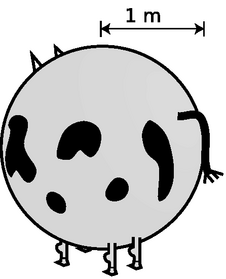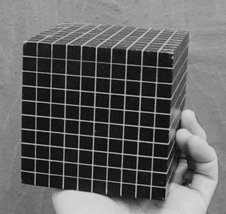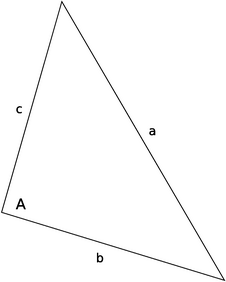You are viewing the html version of Newtonian Physics, by Benjamin Crowell. This version is only designed for casual browsing, and may have some formatting problems.
(c) 1998-2006 Benjamin Crowell, licensed under the Creative Commons Attribution-ShareAlike license, or, at your option, the GFDL license. Photo credits are given at the end of the Adobe Acrobat version.
Section 1.1 - Introduction
Section 1.2 - Scaling of Area and Volume
Section 1.3 - Scaling Applied to Biology (optional)
Section 1.4 - Order-of-Magnitude Estimates
Section 1.5 - Summary

Life would be very different if you were the size of an insect.
Chapter 1. Scaling and Order-of-Magnitude Estimates
1.1 Introduction
Why can't an insect be the size of a dog? Some skinny stretched-out cells in your spinal cord are a meter tall --- why does nature display no single cells that are not just a meter tall, but a meter wide, and a meter thick as well? Believe it or not, these are questions that can be answered fairly easily without knowing much more about physics than you already do. The only mathematical technique you really need is the humble conversion, applied to area and volume.
Area and volume
To many people, it seems hard to believe that a square meter equals 10000 square centimeters, or that a cubic meter equals a million cubic centimeters --- they think it would make more sense if there were 100 cm2 in 1 m2, and 100 cm3 in 1 m3, but that would be incorrect. The examples shown in figure b aim to make the correct answer more believable, using the traditional U.S. units of feet and yards. (One foot is 12 inches, and one yard is three feet.)

b / Visualizing conversions of area and volume using traditional U.S. units.
self-check: Based on figure b, convince yourself that there are 9 ft2 in a square yard, and 27 ft3 in a cubic yard, then demonstrate the same thing symbolically (i.e., with the method using fractions that equal one). (answer in the back of the PDF version of the book)
◊ Solved problem: converting mm2 to cm2 — problem 10
◊ Solved problem: scaling a liter — problem 19
Discussion Question
◊ How many square centimeters are there in a square inch? (1 inch = 2.54 cm) First find an approximate answer by making a drawing, then derive the conversion factor more accurately using the symbolic method.

c / Galileo Galilei (1564-1642) was a Renaissance Italian who brought the scientific method to bear on physics, creating the modern version of the science. Coming from a noble but very poor family, Galileo had to drop out of medical school at the University of Pisa when he ran out of money. Eventually becoming a lecturer in mathematics at the same school, he began a career as a notorious troublemaker by writing a burlesque ridiculing the university's regulations --- he was forced to resign, but found a new teaching position at Padua. He invented the pendulum clock, investigated the motion of falling bodies, and discovered the moons of Jupiter. The thrust of his life's work was to discredit Aristotle's physics by confronting it with contradictory experiments, a program which paved the way for Newton's discovery of the relationship between force and motion. In chapter 3 we'll come to the story of Galileo's ultimate fate at the hands of the Church.
1.2 Scaling of Area and Volume
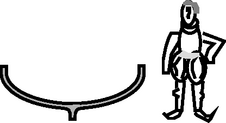
d / The small boat holds up just fine.

e / A larger boat built with the same proportions as the small one will collapse under its own weight.

f / A boat this large needs to have timbers that are thicker compared to its size.

h / Galileo discusses planks made of wood, but the concept may be easier to imagine with clay. All three clay rods in the figure were originally the same shape. The medium-sized one was twice the height, twice the length, and twice the width of the small one, and similarly the large one was twice as big as the medium one in all its linear dimensions. The big one has four times the linear dimensions of the small one, 16 times the cross-sectional area when cut perpendicular to the page, and 64 times the volume. That means that the big one has 64 times the weight to support, but only 16 times the strength compared to the smallest one.

i / The area of a shape is proportional to the square of its linear dimensions, even if the shape is irregular.

j / The muffin comes out of the oven too hot to eat. Breaking it up into four pieces increases its surface area while keeping the total volume the same. It cools faster because of the greater surface-to-volume ratio. In general, smaller things have greater surface-to-volume ratios, but in this example there is no easy way to compute the effect exactly, because the small pieces aren't the same shape as the original muffin.
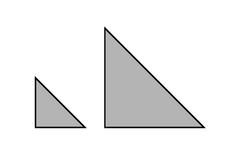
k / Example 1. The big triangle has four times more area than the little one.

l / A tricky way of solving example 1, explained in solution #2.
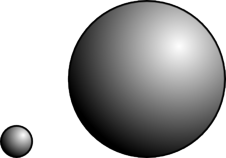
m / Example 2. The big sphere has 125 times more volume than the little one.

n / Example 3. The 48-point “S” has 1.78 times more area than the 36-point “S.”
Great fleas have lesser fleas
Upon their backs to bite 'em.
And lesser fleas have lesser still,
And so ad infinitum. -- Jonathan Swift
Now how do these conversions of area and volume relate to the questions I posed about sizes of living things? Well, imagine that you are shrunk like Alice in Wonderland to the size of an insect. One way of thinking about the change of scale is that what used to look like a centimeter now looks like perhaps a meter to you, because you're so much smaller. If area and volume scaled according to most people's intuitive, incorrect expectations, with 1 m2 being the same as 100 cm2, then there would be no particular reason why nature should behave any differently on your new, reduced scale. But nature does behave differently now that you're small. For instance, you will find that you can walk on water, and jump to many times your own height. The physicist Galileo Galilei had the basic insight that the scaling of area and volume determines how natural phenomena behave differently on different scales. He first reasoned about mechanical structures, but later extended his insights to living things, taking the then-radical point of view that at the fundamental level, a living organism should follow the same laws of nature as a machine. We will follow his lead by first discussing machines and then living things.
Galileo on the behavior of nature on large and small scales
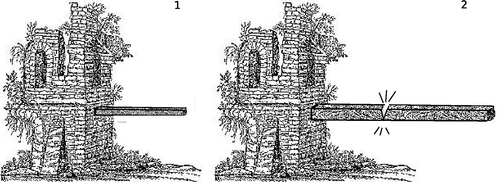
g / 1. This plank is as long as it can be without collapsing under its own weight. If it was a hundredth of an inch longer, it would collapse. 2. This plank is made out of the same kind of wood. It is twice as thick, twice as long, and twice as wide. It will collapse under its own weight.
Also, Galileo is doing something that would be frowned on in modern science: he is mixing experiments whose results he has actually observed (building boats of different sizes), with experiments that he could not possibly have done (dropping an ant from the height of the moon). He now relates how he has done actual experiments with such planks, and found that, according to this operational definition, they are not strong in proportion to their sizes. The larger one breaks. He makes sure to tell the reader how important the result is, via Sagredo's astonished response:Sagredo: My brain already reels. My mind, like a cloud momentarily illuminated by a lightning flash, is for an instant filled with an unusual light, which now beckons to me and which now suddenly mingles and obscures strange, crude ideas. From what you have said it appears to me impossible to build two similar structures of the same material, but of different sizes and have them proportionately strong.
In other words, this specific experiment, using things like wooden planks that have no intrinsic scientific interest, has very wide implications because it points out a general principle, that nature acts differently on different scales.
To finish the discussion, Galileo gives an explanation. He says that the strength of a plank (defined as, say, the weight of the heaviest boulder you could put on the end without breaking it) is proportional to its cross-sectional area, that is, the surface area of the fresh wood that would be exposed if you sawed through it in the middle. Its weight, however, is proportional to its volume.1
How do the volume and cross-sectional area of the longer plank compare with those of the shorter plank? We have already seen, while discussing conversions of the units of area and volume, that these quantities don't act the way most people naively expect. You might think that the volume and area of the longer plank would both be doubled compared to the shorter plank, so they would increase in proportion to each other, and the longer plank would be equally able to support its weight. You would be wrong, but Galileo knows that this is a common misconception, so he has Salviati address the point specifically:
Salviati: ... Take, for example, a cube two inches on a side so that each face has an area of four square inches and the total area, i.e., the sum of the six faces, amounts to twenty-four square inches; now imagine this cube to be sawed through three times [with cuts in three perpendicular planes] so as to divide it into eight smaller cubes, each one inch on the side, each face one inch square, and the total surface of each cube six square inches instead of twenty-four in the case of the larger cube. It is evident therefore, that the surface of the little cube is only one-fourth that of the larger, namely, the ratio of six to twenty-four; but the volume of the solid cube itself is only one-eighth; the volume, and hence also the weight, diminishes therefore much more rapidly than the surface... You see, therefore, Simplicio, that I was not mistaken when ... I said that the surface of a small solid is comparatively greater than that of a large one.
The same reasoning applies to the planks. Even though they are not cubes, the large one could be sawed into eight small ones, each with half the length, half the thickness, and half the width. The small plank, therefore, has more surface area in proportion to its weight, and is therefore able to support its own weight while the large one breaks.
Scaling of area and volume for irregularly shaped objects
Is it always true that something half the size has one quarter the surface area and one eighth the volume, even if it has an irregular shape? Take the example of a child's violin. Violins are made for small children in smaller size to accomodate their small bodies. Figure i shows a full-size violin, along with two violins made with half and 3/4 of the normal length.2 Let's study the surface area of the front panels of the three violins.
Consider the square in the interior of the panel of the full-size violin. In the 3/4-size violin, its height and width are both smaller by a factor of 3/4, so the area of the corresponding, smaller square becomes 3/4×3/4=9/16 of the original area, not 3/4 of the original area. Similarly, the corresponding square on the smallest violin has half the height and half the width of the original one, so its area is 1/4 the original area, not half.
The same reasoning works for parts of the panel near the edge, such as the part that only partially fills in the other square. The entire square scales down the same as a square in the interior, and in each violin the same fraction (about 70%) of the square is full, so the contribution of this part to the total area scales down just the same.
Since any small square region or any small region covering part of a square scales down like a square object, the entire surface area of an irregularly shaped object changes in the same manner as the surface area of a square: scaling it down by 3/4 reduces the area by a factor of 9/16, and so on.
In general, we can see that any time there are two objects with the same shape, but different linear dimensions (i.e., one looks like a reduced photo of the other), the ratio of their areas equals the ratio of the squares of their linear dimensions:

Note that it doesn't matter where we choose to measure the linear size, L, of an object. In the case of the violins, for instance, it could have been measured vertically, horizontally, diagonally, or even from the bottom of the left f-hole to the middle of the right f-hole. We just have to measure it in a consistent way on each violin. Since all the parts are assumed to shrink or expand in the same manner, the ratio L1/L2 is independent of the choice of measurement.
It is also important to realize that it is completely unnecessary to have a formula for the area of a violin. It is only possible to derive simple formulas for the areas of certain shapes like circles, rectangles, triangles and so on, but that is no impediment to the type of reasoning we are using.
Sometimes it is inconvenient to write all the equations in terms of ratios, especially when more than two objects are being compared. A more compact way of rewriting the previous equation is
The symbol “∝” means “is proportional to.” Scientists and engineers often speak about such relationships verbally using the phrases “scales like” or “goes like,” for instance “area goes like length squared.”
All of the above reasoning works just as well in the case of volume. Volume goes like length cubed:
If different objects are made of the same material with the same density, ρ =m/V, then their masses, m=ρ V, are proportional to L3, and so are their weights. (The symbol for density is ρ, the lower-case Greek letter “rho.”)
An important point is that all of the above reasoning about scaling only applies to objects that are the same shape. For instance, a piece of paper is larger than a pencil, but has a much greater surface-to-volume ratio.
One of the first things I learned as a teacher was that students were not very original about their mistakes. Every group of students tends to come up with the same goofs as the previous class. The following are some examples of correct and incorrect reasoning about proportionality.
Example 1: Scaling of the area of a triangle
◊ In figure k, the larger triangle has sides twice as long. How many times greater is its area?Correct solution #1: Area scales in proportion to the square of the linear dimensions, so the larger triangle has four times more area (22=4).
Correct solution #2: You could cut the larger triangle into four of the smaller size, as shown in fig. (b), so its area is four times greater. (This solution is correct, but it would not work for a shape like a circle, which can't be cut up into smaller circles.)
Correct solution #3: The area of a triangle is given by
A=bh/2, where b is the base and h is the height. The areas of the triangles are
(Although this solution is correct, it is a lot more work than solution #1, and it can only be used in this case because a triangle is a simple geometric shape, and we happen to know a formula for its area.)
Correct solution #4: The area of a triangle is A= bh/2. The comparison of the areas will come out the same as long as the ratios of the linear sizes of the triangles is as specified, so let's just say b1=1.00 m and b2=2.00 m. The heights are then also h1=1.00 m and h2=2.00 m, giving areas A1=0.50 m2 and A2=2.00 m2, so A2/A1=4.00.
(The solution is correct, but it wouldn't work with a shape for whose area we don't have a formula. Also, the numerical calculation might make the answer of 4.00 appear inexact, whereas solution #1 makes it clear that it is exactly 4.)
Incorrect solution: The area of a triangle is A=bh, and if you plug in b=2.00 m and h=2.00 m, you get A=2.00 m2, so the bigger triangle has 2.00 times more area. (This solution is incorrect because no comparison has been made with the smaller triangle.)
Example 2: Scaling of the volume of a sphere
◊ In figure m, the larger sphere has a radius that is five times greater. How many times greater is its volume?Correct solution #1: Volume scales like the third power of the linear size, so the larger sphere has a volume that is 125 times greater (53=125).
Correct solution #2: The volume of a sphere is V=(4/3)π r3, so




Incorrect solution: The volume of a sphere is V=(4/3)π r3, so




(The solution is incorrect because (5r1)3 is not the same as 5r13.)
Example 3: Scaling of a more complex shape
◊ The first letter “S” in figure n is in a 36-point font, the second in 48-point. How many times more ink is required to make the larger “S”? (Points are a unit of length used in typography.)Correct solution: The amount of ink depends on the area to be covered with ink, and area is proportional to the square of the linear dimensions, so the amount of ink required for the second “S” is greater by a factor of (48/36)2=1.78.
Incorrect solution: The length of the curve of the second “S” is longer by a factor of 48/36=1.33, so 1.33 times more ink is required.
(The solution is wrong because it assumes incorrectly that the width of the curve is the same in both cases. Actually both the width and the length of the curve are greater by a factor of 48/36, so the area is greater by a factor of (48/36)2=1.78.)
◊ Solved problem: a telescope gathers light — problem 11
◊ Solved problem: distance from an earthquake — problem 12
Discussion Questions
◊ A toy fire engine is 1/30 the size of the real one, but is constructed from the same metal with the same proportions. How many times smaller is its weight? How many times less red paint would be needed to paint it?
◊ Galileo spends a lot of time in his dialog discussing what really happens when things break. He discusses everything in terms of Aristotle's now-discredited explanation that things are hard to break, because if something breaks, there has to be a gap between the two halves with nothing in between, at least initially. Nature, according to Aristotle, “abhors a vacuum,” i.e., nature doesn't “like” empty space to exist. Of course, air will rush into the gap immediately, but at the very moment of breaking, Aristotle imagined a vacuum in the gap. Is Aristotle's explanation of why it is hard to break things an experimentally testable statement? If so, how could it be tested experimentally?
1.3 Scaling Applied to Biology (optional)
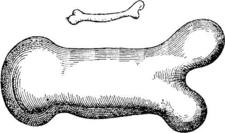
q / Galileo's original drawing, showing how larger animals' bones must be greater in diameter compared to their lengths.
Organisms of different sizes with the same shape
The left-hand panel in figure o shows the approximate validity of the proportionality m∝ L3 for cockroaches (redrawn from McMahon and Bonner). The scatter of the points around the curve indicates that some cockroaches are proportioned slightly differently from others, but in general the data seem well described by m∝ L3. That means that the largest cockroaches the experimenter could raise (is there a 4-H prize?) had roughly the same shape as the smallest ones.
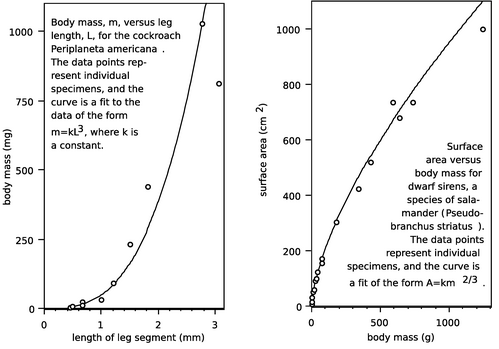
o / Geometrical scaling of animals.
Another relationship that should exist for animals of different sizes shaped in the same way is that between surface area and body mass. If all the animals have the same average density, then body mass should be proportional to the cube of the animal's linear size, m∝ L3, while surface area should vary proportionately to L2. Therefore, the animals' surface areas should be proportional to m2/3. As shown in the right-hand panel of figure o, this relationship appears to hold quite well for the dwarf siren, a type of salamander. Notice how the curve bends over, meaning that the surface area does not increase as quickly as body mass, e.g., a salamander with eight times more body mass will have only four times more surface area.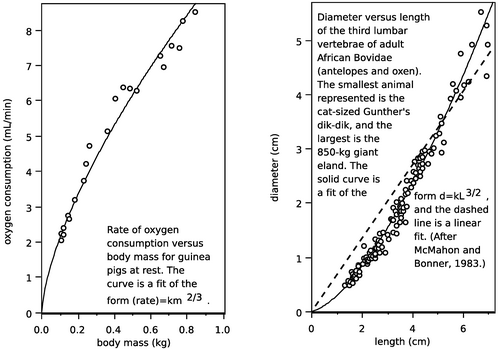
p / Scaling of animals' bodies related to metabolic rate and skeletal strength.
This behavior of the ratio of surface area to mass (or, equivalently, the ratio of surface area to volume) has important consequences for mammals, which must maintain a constant body temperature. It would make sense for the rate of heat loss through the animal's skin to be proportional to its surface area, so we should expect small animals, having large ratios of surface area to volume, to need to produce a great deal of heat in comparison to their size to avoid dying from low body temperature. This expectation is borne out by the data of the left-hand panel of figure p, showing the rate of oxygen consumption of guinea pigs as a function of their body mass. Neither an animal's heat production nor its surface area is convenient to measure, but in order to produce heat, the animal must metabolize oxygen, so oxygen consumption is a good indicator of the rate of heat production. Since surface area is proportional to m2/3, the proportionality of the rate of oxygen consumption to m2/3 is consistent with the idea that the animal needs to produce heat at a rate in proportion to its surface area. Although the smaller animals metabolize less oxygen and produce less heat in absolute terms, the amount of food and oxygen they must consume is greater in proportion to their own mass. The Etruscan pigmy shrew, weighing in at 2 grams as an adult, is at about the lower size limit for mammals. It must eat continually, consuming many times its body weight each day to survive.Changes in shape to accommodate changes in size
If the shape stayed the same regardless of size, then all linear dimensions, including d and L, would be proportional to one another. If our reasoning holds, then the fact that d is proportional to L3/2, not L, implies a change in proportions of the bone. As shown in the right-hand panel of figure p, the vertebrae of African Bovidae follow the rule d∝ L3/2 fairly well. The vertebrae of the giant eland are as chunky as a coffee mug, while those of a Gunther's dik-dik are as slender as the cap of a pen.
Discussion Questions
◊ Single-celled animals must passively absorb nutrients and oxygen from their surroundings, unlike humans who have lungs to pump air in and out and a heart to distribute the oxygenated blood throughout their bodies. Even the cells composing the bodies of multicellular animals must absorb oxygen from a nearby capillary through their surfaces. Based on these facts, explain why cells are always microscopic in size.
◊ The reasoning of the previous question would seem to be contradicted by the fact that human nerve cells in the spinal cord can be as much as a meter long, although their widths are still very small. Why is this possible?
1.4 Order-of-Magnitude Estimates
It is the mark of an instructed mind to rest satisfied with the degree of precision that the nature of the subject permits and not to seek an exactness where only an approximation of the truth is possible. -- Aristotle
It is a common misconception that science must be exact. For instance, in the Star Trek TV series, it would often happen that Captain Kirk would ask Mr. Spock, “Spock, we're in a pretty bad situation. What do you think are our chances of getting out of here?” The scientific Mr. Spock would answer with something like, “Captain, I estimate the odds as 237.345 to one.” In reality, he could not have estimated the odds with six significant figures of accuracy, but nevertheless one of the hallmarks of a person with a good education in science is the ability to make estimates that are likely to be at least somewhere in the right ballpark. In many such situations, it is often only necessary to get an answer that is off by no more than a factor of ten in either direction. Since things that differ by a factor of ten are said to differ by one order of magnitude, such an estimate is called an order-of-magnitude estimate. The tilde, ∼, is used to indicate that things are only of the same order of magnitude, but not exactly equal, as in

The tilde can also be used in front of an individual number to emphasize that the number is only of the right order of magnitude.
Although making order-of-magnitude estimates seems simple and natural to experienced scientists, it's a mode of reasoning that is completely unfamiliar to most college students. Some of the typical mental steps can be illustrated in the following example.
Example 4: Cost of transporting tomatoes
◊ Roughly what percentage of the price of a tomato comes from the cost of transporting it in a truck?
◊ The following incorrect solution illustrates one of the main ways you can go wrong in order-of-magnitude estimates.
Incorrect solution: Let's say the trucker needs to make a $400 profit on the trip. Taking into account her benefits, the cost of gas, and maintenance and payments on the truck, let's say the total cost is more like $2000. I'd guess about 5000 tomatoes would fit in the back of the truck, so the extra cost per tomato is 40 cents. That means the cost of transporting one tomato is comparable to the cost of the tomato itself. Transportation really adds a lot to the cost of produce, I guess.
The problem is that the human brain is not very good at estimating area or volume, so it turns out the estimate of 5000 tomatoes fitting in the truck is way off. That's why people have a hard time at those contests where you are supposed to estimate the number of jellybeans in a big jar. Another example is that most people think their families use about 10 gallons of water per day, but in reality the average is about 300 gallons per day. When estimating area or volume, you are much better off estimating linear dimensions, and computing volume from the linear dimensions. Here's a better solution:
Better solution: As in the previous solution, say the cost of the trip is $2000. The dimensions of the bin are probably 4 m × 2 m × 1 m, for a volume of 8 m3. Since the whole thing is just an order-of-magnitude estimate, let's round that off to the nearest power of ten, 10 m3. The shape of a tomato is complicated, and I don't know any formula for the volume of a tomato shape, but since this is just an estimate, let's pretend that a tomato is a cube, 0.05 m × 0.05 m × 0.05 m, for a volume of 1.25×10-4 m3. Since this is just a rough estimate, let's round that to 10-4 m3. We can find the total number of tomatoes by dividing the volume of the bin by the volume of one tomato: 10 m3/10-4 m3=105 tomatoes. The transportation cost per tomato is $$2000/10^5$ tomatoes=$0.02/tomato. That means that transportation really doesn't contribute very much to the cost of a tomato.
Approximating the shape of a tomato as a cube is an example of another general strategy for making order-of-magnitude estimates. A similar situation would occur if you were trying to estimate how many m2 of leather could be produced from a herd of ten thousand cattle. There is no point in trying to take into account the shape of the cows' bodies. A reasonable plan of attack might be to consider a spherical cow. Probably a cow has roughly the same surface area as a sphere with a radius of about 1 m, which would be 4π (1 m)2. Using the well-known facts that pi equals three, and four times three equals about ten, we can guess that a cow has a surface area of about 10 m2, so the herd as a whole might yield 105 m2 of leather.
The following list summarizes the strategies for getting a good order-of-magnitude estimate.
- Don't even attempt more than one significant figure of precision.
- Don't guess area or volume directly. Guess linear dimensions and get area or volume from them.
- When dealing with areas or volumes of objects with complex shapes, idealize them as if they were some simpler shape, a cube or a sphere, for example.
- Check your final answer to see if it is reasonable. If you estimate that a herd of ten thousand cattle would yield 0.01 m2 of leather, then you have probably made a mistake with conversion factors somewhere.
Summary
Homework Problems
1. How many cubic inches are there in a cubic foot? The answer is not 12.(answer check available at lightandmatter.com)
2. Assume a dog's brain is twice is great in diameter as a cat's, but each animal's brain cells are the same size and their brains are the same shape. In addition to being a far better companion and much nicer to come home to, how many times more brain cells does a dog have than a cat? The answer is not 2.
3. The population density of Los Angeles is about 4000 people/km2. That of San Francisco is about 6000 people/km2. How many times farther away is the average person's nearest neighbor in LA than in San Francisco? The answer is not 1.5. (answer check available at lightandmatter.com)
4. A hunting dog's nose has about 10 square inches of active surface. How is this possible, since the dog's nose is only about 1 in × 1 in × 1 in = 1  After all, 10 is greater than 1, so how can it fit?
After all, 10 is greater than 1, so how can it fit?
6. In a computer memory chip, each bit of information (a 0 or a 1) is stored in a single tiny circuit etched onto the surface of a silicon chip. The circuits cover the surface of the chip like lots in a housing development. A typical chip stores 64 Mb (megabytes) of data, where a byte is 8 bits. Estimate (a) the area of each circuit, and (b) its linear size.
7. Suppose someone built a gigantic apartment building, measuring 10 km × 10 km at the base. Estimate how tall the building would have to be to have space in it for the entire world's population to live.
8. A hamburger chain advertises that it has sold 10 billion Bongo Burgers. Estimate the total mass of feed required to raise the cows used to make the burgers.
11. (solution in the pdf version of the book) Compare the light-gathering powers of a 3-cm-diameter telescope and a 30-cm telescope.
12. (solution in the pdf version of the book) One step on the Richter scale corresponds to a factor of 100 in terms of the energy absorbed by something on the surface of the Earth, e.g., a house. For instance, a 9.3-magnitude quake would release 100 times more energy than an 8.3. The energy spreads out from the epicenter as a wave, and for the sake of this problem we'll assume we're dealing with seismic waves that spread out in three dimensions, so that we can visualize them as hemispheres spreading out under the surface of the earth. If a certain 7.6-magnitude earthquake and a certain 5.6-magnitude earthquake produce the same amount of vibration where I live, compare the distances from my house to the two epicenters.
13. In Europe, a piece of paper of the standard size, called A4, is a little narrower and taller than its American counterpart. The ratio of the height to the width is the square root of 2, and this has some useful properties. For instance, if you cut an A4 sheet from left to right, you get two smaller sheets that have the same proportions. You can even buy sheets of this smaller size, and they're called A5. There is a whole series of sizes related in this way, all with the same proportions. (a) Compare an A5 sheet to an A4 in terms of area and linear size. (b) The series of paper sizes starts from an A0 sheet, which has an area of one square meter. Suppose we had a series of boxes defined in a similar way: the B0 box has a volume of one cubic meter, two B1 boxes fit exactly inside an B0 box, and so on. What would be the dimensions of a B0 box? (answer check available at lightandmatter.com)
15. According to folklore, every time you take a breath, you are inhaling some of the atoms exhaled in Caesar's last words. Is this true? If so, how many?
16. The Earth's surface is about 70% water. Mars's diameter is about half the Earth's, but it has no surface water. Compare the land areas of the two planets.
17. (solution in the pdf version of the book) The traditional Martini glass is shaped like a cone with the point at the bottom. Suppose you make a Martini by pouring vermouth into the glass to a depth of 3 cm, and then adding gin to bring the depth to 6 cm. What are the proportions of gin and vermouth?
18. The central portion of a CD is taken up by the hole and some surrounding clear plastic, and this area is unavailable for storing data. The radius of the central circle is about 35% of the radius of the data-storing area. What percentage of the CD's area is therefore lost? (answer check available at lightandmatter.com)
19. The one-liter cube in the photo has been marked off into smaller cubes, with linear dimensions one tenth those of the big one. What is the volume of each of the small cubes?(solution in the pdf version of the book)
20. (solution in the pdf version of the book) (a) Based on the definitions of the since, cosine, and tangent, what units must they have? (b) A cute formula from trigonometry lets you find any angle of a triangle if you know the lengths of its sides. Using the notation shown in the figure, and letting s=(a+b+c)/2 be half the perimeter, we have

Show that the units of this equation make sense. In other words, check that the units of the right-hand side are the same as your answer to part a of the question.
21. Estimate the number of man-hours required for building the Great Wall of China. (solution in the pdf version of the book)
22. (a) Using the microscope photo in the figure, estimate the mass of a one cell of the E. coli bacterium, which is one of the most common ones in the human intestine. Note the scale at the lower right corner, which is 1 μm. Each of the tubular objects in the column is one cell. (b) The feces in the human intestine are mostly bacteria (some dead, some alive), of which E. coli is a large and typical component. Estimate the number of bacteria in your intestines, and compare with the number of human cells in your body, which is believed to be roughly on the order of 1013. (c) Interpreting your result from part b, what does this tell you about the size of a typical human cell compared to the size of a typical bacterial cell?







